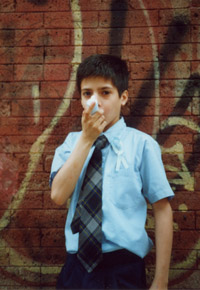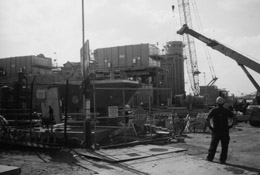|
Back to On the Road with John Tarleton
The High price of Energy: Power Plants Take Toll on City's Kids
by John Tarleton NEW YORK CITY—Ray Berly is a polite, soft-spoken 10-year-old with short, dark hair and a sky blue ribbon pinned to his neatly pressed Catholic school uniform. He dreams of being a paleontologist and has a small library of dinosaur books. Basketball is his favorite sport but he gets red in the face when he tries to run around with other kids.
Rayís asthma may get worse starting June 1 when the New York Power Authority (NYPA) brings ten new mini-power plants on-line in poor, heavily polluted neighborhoods along the East River. Four of the new power plants will be installed in the South Bronx, which has the nationís highest asthma rate. They will be just upwind from where Ray goes to school at on E. 145th St.
"A Death Warrant On Our Children"Invoking the spectre of California-style blackouts this summer, NYPA is also installing one power plant in Williamsburg, Brooklyn; two in Sunset Park, Brooklyn; two in Long Island City, Queens and one in Rosebank, Staten Island. The neighborhoods within a half-mile of the power plants are all poorer and have higher percentages of minorities than the city as a whole, according to a NYPA assessment that was first made public by the New York Times. The study also reported each site has, on average, 100 other facilities with air pollution permits within one mile of them. "I feel like he (Governor George Pataki) is sending out a death warrant on our children," said Darlene Santiago of Mothers on the Move, a South Bronx-based civic organization. Santiagoís 12-year-old daughter suffers from asthma and has made repeated trips to the hospital. "On any given day you can find the asthma wards in the Bronx hospitals full," Santiago said. NYPA spokesperson Joe Leary said that site selection was based on existing electrical hook-ups and that environmental racism was not a factor. "These are the cleanest plants in the city," Leary said. However according to the same NYPA assessment, each 44-megawatt, gas-burning turbine could produce as much 61 tons per year of pollutants such as sulfur dioxide, carbon monoxide, particulate matter, nitrogen oxides and volatile organic compounds such as benzopyrene and formaldehyde.
Maldonado also points out that General Electric, which polluted the Hudson River for decades with PCBs and has yet to comply with state cleanup laws, manufactures the turbines. "How can we trust this company?" Maldonado asked. "They donít have such a great track record on the environment."
Grassroots ResistanceA citywide network of neighborhood activists has emerged to fight the new power plants. Two people were arrested outside Governor Patakiís midtown Manhattan office on May 7 and protesters picketed outside a $300 per plate dinner ceremony on May 14 in which the League of Conservation Voters honored the governor as New Yorkís "Environmentalist of the Year". Protests have also occurred at construction sites in Sunset Park (May 12), Long Island City (May 19) and Williamsburg (May 22), which is also battling a proposed new 1,000-1,500 megawatt co-generation plant at the Bayside Fuel Oil site at North 12th St. and Kent Ave. Local Democratic pols, including Congresswoman Nydia Velasquez (D-Brooklyn) and Bronx Borough President (and mayoral hopeful) Fernando Ferrer, turned out for the Sunset Park protest. While cars roared overhead on the Gowanus Expressway, Velasquez noted that she now had seven power plants in her district. Ferrer criticized NYPA for wiggling out of doing a full Environmental Impact Review, which would have required a six-month public comment period. When people were asked to raise their hand if they had asthma or knew someone with asthma, almost everyone in the crowd of 75 people raised their hand. "Will these plants make parents and their children sicker than they are?" Ferrer asked. "We deserve an answer to that question." New York City has 13,474 megawatts of energy available, almost 30% more than is needed during the hottest summer days, according to the National Resources Defense Council. The ten new plants will augment the areaís power supply by 3-4%, an amount that could be covered by increased energy conservation and the development of less-polluting energy sources like solar or wind power. "The technology is feasible," said Beth Cullenane of Clean Power for the People. "But, the state needs to be more pro-active in using it."
The NebulizerRamon Marrero compares an asthma attack to drowning on land or having to breathe through a straw. He had to pick his son up at school seven times last semester. Rayís most recent asthma attack occurred in mid-April just before Easter vacation. It lasted a week. "You canít breathe," Ray said. "Youíre coughing and wheezing and stuffs coming up in your throat. It makes me think of death." In his lunch box-sized nebulizer, Ray has a mini-power plant of sorts. When an attack begins, he plugs the machine into a wall and clamps a transparent mask over his mouth and nose. The pump inside the nebulizer makes a noisy hum and sends warm air up a 3-foot long plastic tube. The warm air mixes inside a filter with liquid albuterol and Ray breaths the mist deep into his lungs. "Itís too much to put a kid through, if it can be avoided," said Marrero who also volunteers at Pueblo en Marcha. Marrero expects the battle against the power plants to continue past June 1, both in the courts and on the streets. "I take the approach that we havenít lost as long as weíre fighting," Marrero said. Meanwhile, a fifth grader in the South Bronx is hoping that the state of New York will rethink its current energy policies. "I donít want more power plants," Ray said. "Itís bad enough already." This story originally appeared in the May 2001 New York Indypendent. LINKS:
Communities United for Responsible Energy (CURE) Back to On the Road with John Tarleton
|
 "Most parents say to their kids, Ďdo you have your lunch?í when they leave for school," said Ramon Marrero, 48, Rayís stepfather. "We have to say, Ďdo you have your nebulizer?í"
"Most parents say to their kids, Ďdo you have your lunch?í when they leave for school," said Ramon Marrero, 48, Rayís stepfather. "We have to say, Ďdo you have your nebulizer?í"
 "I donít think people understand what they mean by Ďcleaní," said Ana Maldonado of Pueblo en Marcha, another South Bronx based organization. "It might be cleaner than what they used before. But, itís still going to pollute."
"I donít think people understand what they mean by Ďcleaní," said Ana Maldonado of Pueblo en Marcha, another South Bronx based organization. "It might be cleaner than what they used before. But, itís still going to pollute."